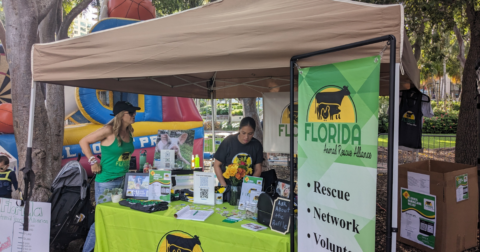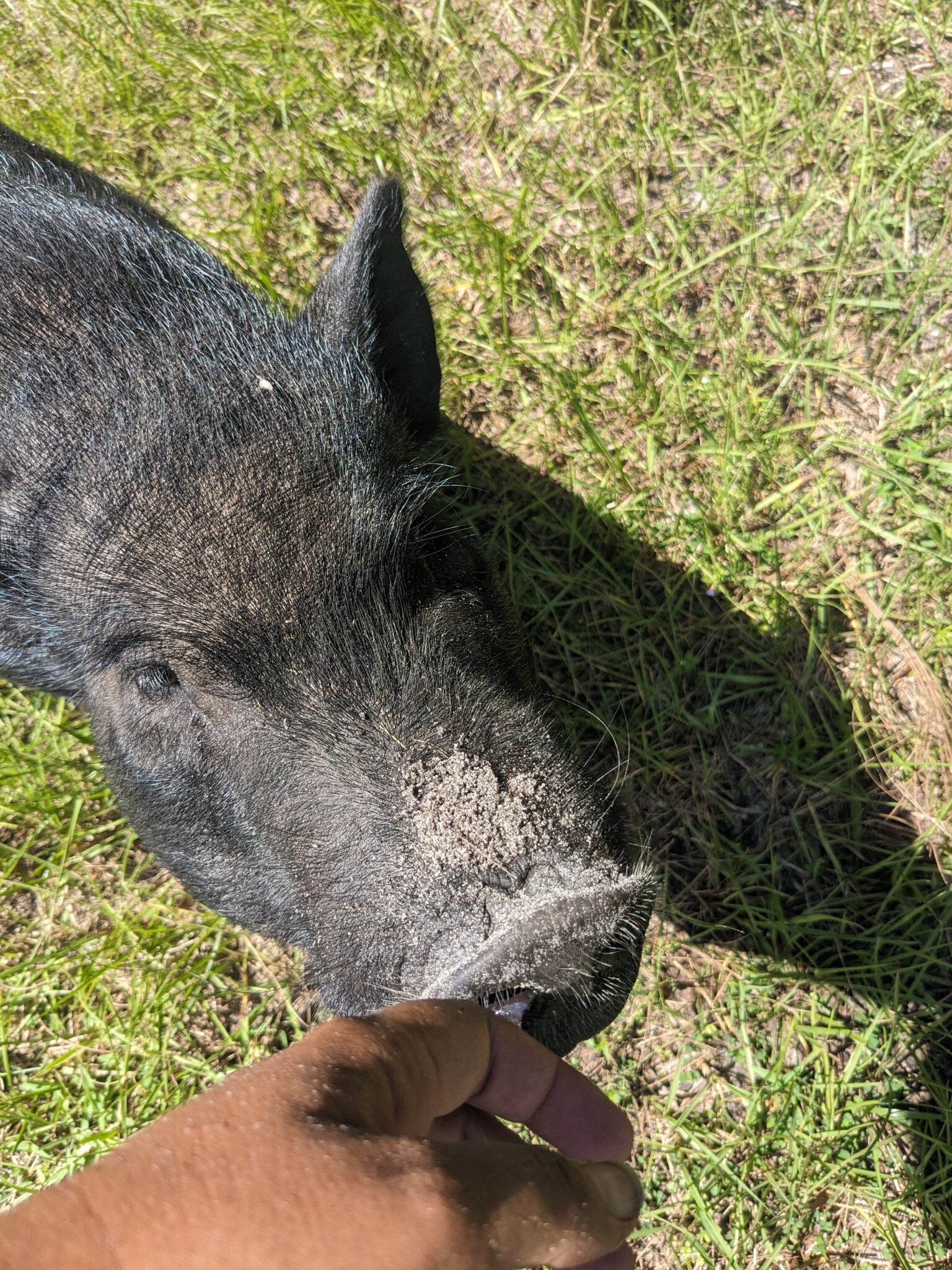News
Senate Finally OKs Plant-Based Milk in Public Schools
Policy•5 min read
Solutions
FARA is helping fill in the gaps animal sanctuaries face.


Words by Grace Hussain
It’s a sunny Saturday, and I’ve joined a group of about two dozen volunteers at a farm sanctuary in rural Palm Beach County, Florida. Couched between the houses that sparsely dot the landscape sits the sanctuary, home to several pigs, a handful of sheep, a trio of geese, one very sweet pony and several other rescued farm animals. While the animals have made their way to the sanctuary from a variety of backgrounds — some having endured abuse at the hands of prior owners, while others were saved from slaughterhouses — the people present have been brought together by a shared love of the animals and a unique nonprofit: Florida Animal Rescue Alliance (FARA), founded and run by Karol Lopez, and a dedicated group of volunteers.
An avid animal advocate, Lopez noticed that the sanctuaries in her home state of Florida weren’t communicating well, and that their impact was suffering as a result. “Before FARA, there was very little communication between sanctuaries in Florida,” she tells Sentient. “Most orgs were working in isolation — dealing with burnout, limited resources and crisis after crisis, without a network to turn to.”
Some of those challenges have increased since President Trump took office earlier this year, in large part due to reduced enforcement of the Animal Welfare Act and weakened environmental regulations, she says. But animal sanctuaries face issues regardless of which party holds the presidency. “The challenges sanctuaries face are deeply systemic,” she says, citing low funding, zoning laws and the massive number of animals that need placement.
Lopez founded FARA in 2023 to unite sanctuaries and animal-loving people across the state, and to increase their impact for the animals. Her vision is simple: “A short-term goal would be to help bring together [people] to help them see that whether you’re an activist, whether you’re here for the environment, whether you like the food, [you can] come help out.”
The organization focuses on doing two things: organizing volunteer groups to support sanctuaries’ needs, and bringing organizations themselves together to support each other and the animals. Since their founding, FARA has helped just shy of 100 animals find forever homes.
Back at the sanctuary, the organization runs with a singular goal: making sure the animal residents are happy. It’s one of the reasons they’re hosting us as volunteers today— the goats need an updated playground. Deep-cleaning stalls, and emptying out and relaying bedding in a chicken coop are just two of the other tasks we’re slated to tackle that day.
Grace Van de Pas is one of the other volunteers rolling up her sleeves. When she moved to the area in 2023, she was excited to stay engaged with the animal protection movement by volunteering at a sanctuary, but was discouraged by the lack of sanctuaries taking on new volunteers. That was, until she heard about a volunteer opportunity through FARA to help build a fence at a new sanctuary that had just committed to taking in their first pig-resident.
“[The sanctuary] had a very small farm that did exotic fruit growing, and she had taken some rescue animals in, and her husband had passed away,” Van de Pas tells Sentient. “It was really just her maintaining this [farm], and so we were able to go in and assist as a thank you for helping this pig out who really needed adoption.”
Van de Pas, who has since moved into the role of animal welfare operations director with FARA, is familiar with the struggle of maintaining a reliable volunteer network. “I know in the past, having done work with animal nonprofits, a lot goes into training volunteers, and it’s not uncommon for people to stop coming. And when they do stop coming, that was a lot of resources put in without the payoff,” she says.
FARA takes the worry of investing in volunteers who stop showing up off of the sanctuaries, by cultivating their own list of people willing to lend a hand, and putting out calls for events as sanctuaries need the support, usually for larger projects. According to Lopez, they currently have about 85 volunteers on their list. “It’s not that they volunteer regularly, it’s just, you know, whenever they have the availability.”
Some of the volunteers are recruited by word of mouth. . Others sign up to join the list at one of the many community events FARA hosts or tables at. Tucked into a corner by a blowup children’s game, I find the non-profit’s table at Palm Beach’s Vegan Block Party. Van de Pas is there already and has been for hours setting up, speaking to the people who walk up to the table, and encouraging them to sign up for their email list.
Their table is spread with an array of stickers, and they’re selling raffle tickets for a vegan leather bag. Though the organization is fully volunteer-run, they still have expenses — many related to care for the animals. “A lot of [funding] is just coming from out-of-pocket,” says Lopez. The organization does have a few monthly donors. Although their contributions aren’t enough to cover operating expenses, Lopez is still very grateful for their support. “Regardless of what we get, it’s amazing. I’m grateful,” she says.
Rather than supporting the organization itself, she finds donors are more engaged when FARA asks for donations for specific animals. When it comes to funding their work long-term, the next step is to start applying for grants. But that’s a heavy lift for an organization made up of volunteers who also hold full-time jobs on top of their volunteer work.
For now, they’re taking advantage of opportunities like Give Miami Day — a day when residents are encouraged to donate to local nonprofits. “We’re trying to push it out there,” says Lopez, and “get more into the I don’t know what to call it, the game of non profit.” Still, in order to get to where they want to be, they’re either going to need more resources so they can pay someone for their work, or more volunteers dedicated to grant writing.

Back at the sanctuary in Palm Beach County, we’re told the ground rules: The animal residents get to decide if they want to interact. The animals can come up to us, but if they move away from us, we are to leave them alone. All of the animals are at different stages in their healing journey. While some of the residents, especially those who have lived at the sanctuary the longest, are quick to approach and elicit attention, others are more wary of people. A particularly relaxed group of pigs and sheep prefer naps to saying hello.
All the sanctuaries in their network have a similar mission for the animals, says Lopez. Most of the communication with the network takes place online via a series of channels on WhatsApp. “One of our channels is a rescue channel,” Lopez says. That’s where sanctuaries share if they need help with an animal. “It could be either for adoption or rehoming, for foster,” she says, “when, for example, a pig comes in, and a sanctuary gets contacted, and they don’t have the availability, they’ll put it into that channel, and pretty much everyone’s able to see.” Whether a sanctuary quickly steps up often depends on the species.
Roosters are particularly difficult to place, says Lopez. Regardless of species, if no sanctuary volunteers to take the animal in, that’s when FARA starts outreach to their contacts outside the channel. At that stage, the nonprofit doesn’t limit themselves by state lines, instead reaching out to organizations around the country to find placement.
Many of the animals who enter their care are in a rough condition, notes Van de Pas, who uses her past experience in the veterinary field to support their care directly. One of the ways they’re able to afford care is through the generosity of local veterinarians. One local vet, Dr. Santiago Forteza, is an especially important ally in their work, notes Van de Pas. “He’s kind of like an on-call vet for us to ask questions to,” she says. “There’s a lot of vets who, because they love animals, they’re willing to help out and put in discounts for nonprofits.”
Still, finding veterinary care that meets their standards can be challenging. Many large-animal veterinarians are used to treating farmed animals as destined for the food system, so the treatments they consider are more limited. “[Vets] won’t necessarily be trained in what to give an animal that would not go on to be eaten by a human later, because you wouldn’t give them certain things that won’t come out of the system easily,” she says. Once they’re given certain treatments, “they can no longer give milk, or they can no longer be used for human consumption.”
Part of their work is ensuring each animal is healthy before placing them with one of the sanctuaries in their network. “We don’t want to bring an animal over to the sanctuary and then it has some sort of virus or parasite that it could pass over to the other animals,” she says. Having a network of veterinarians is important not just for FARA, but for the sanctuaries they serve. Connecting sanctuaries with veterinarians who know how to care for farmed animals outside of the food system is just one of the many ways that FARA supports their network.
For Lopez, FARA’s role protecting the sanctuaries in their network is just as important as protecting the animals; after all, without the sanctuaries, the animals would have no place to go. It’s the major reason she’s cautious with releasing any location information. In the past, people have abandoned animals at the sanctuaries, assuming that they have the resources to take care of them. However, that’s rarely the case, as each sanctuary has to carefully consider the resources they have, and how many mouths they can feed with their oftentimes shoestring budgets.
Animals aren’t just abandoned outright — many are dropped off by people who claim they’ll be back, but who never return. FARA is stepping up to help their network handle this by outlining contracts that the sanctuaries can enforce if necessary. “It’s super important to have paperwork for protection, not just for them, but for the animals,” Lopez says.
The work that FARA, the sanctuaries within their network and volunteers do is for the animals. As my day mucking out a chicken coop and feeding pigs bananas comes to an end, the volunteers gather around a meal of plant-based sandwiches and desserts donated by local restaurants. Though we’re all covered in sweat and dirt, hands sprayed off by a hose and cleaned with sanitizer, we laugh as the goats explore their new playground, exhausted but glad at the chance to make their lives a little better.